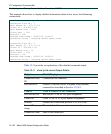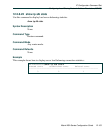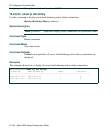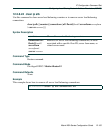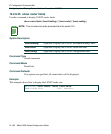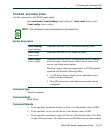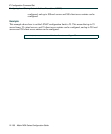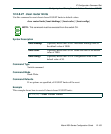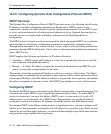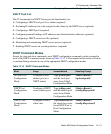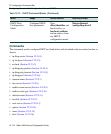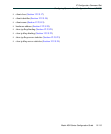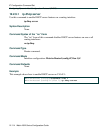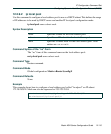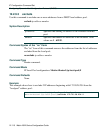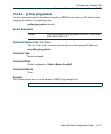
IP Configuration Command Set
Configuring Dynamic Host Configuration Protocol (DHCP)
12-110 Matrix NSA Series Configuration Guide
12.2.9 Configuring Dynamic Host Configuration Protocol (DHCP)
DHCP Overview
The Dynamic Host Configuration Protocol (DHCP) provides services for allocating and delivering
IP addresses and other configuration parameters to Internet hosts. DHCP consists of two
components: a protocol for delivering host-specific configuration parameters from a DHCP server
to a host, and a mechanism for allocating network addresses to hosts. Optional functionality also
provides services to complete high-availability, authenticated and QoS-dependant host
configuration.
The DHCP protocol is based on a client-server model in which a designated DHCP server allocates
network addresses and delivers configuration parameters to dynamically configured clients.
Throughout the remainder of this section, the term “server” refers to a host providing initialization
parameters through DHCP, and the term “client” refers to a host requesting initialization parameters
from a DHCP server.
DHCP supports the following mechanisms for IP address allocation:
• Automatic — DHCP assigns an IP address to a client for a limited period of time (or until the
client explicitly relinquishes the address).
• Manual — A client's IP address is assigned by the network administrator, and DHCP is used
simply to convey the assigned address to the client.
The amount of time that a particular IP address is valid for a system is called a lease. The Matrix
routing module or standalone device maintains a lease database which contains information about
each assigned IP address, the MAC address to which it is assigned, the lease expiration, and whether
the address assignment is dynamic or static. The DHCP lease database is stored in flash memory.
Configuring DHCP
By default, the DHCP server is not enabled on the Matrix routing module or standalone device. You
can selectively enable DHCP service on particular interfaces and not others. To enable DHCP
service on an interface, you must first define a DHCP scope. A scope consists of a pool of IP
addresses and a set of parameters for a DHCP client. The parameters are used by the client to
configure its network environment, for example, the default gateway and DNS domain name.
To configure DHCP on the Matrix routing module or standalone device, you must configure an IP
address pool, client parameters, and optional static IP address for a specified scope. Where several
subnets are accessed through a single port, you can also define multiple scopes on the same interface
and group the scopes together into a superscope.



